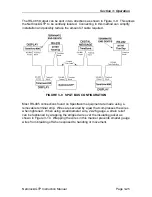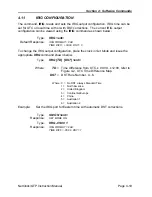
Section 4: Software Commands
Page 4-8
NetClock/GTP Instruction Manual
4.6
DISPLAY TRACKING HISTOGRAM
This command outputs the tracking histogram. The histogram records the number of
qualified satellites tracked each second. At the end of every hour, a log entry is created
and the counters start again. The command responds with the last four hourly entries of
the histogram and current histogram in process. The tracking histogram is useful in
verifying receiver and antenna performance.
Type:
DH <ent>
The tracking histogram is output in the following format:
TIME= HH:MM:SS DATE= YYYY-MM-DD QUALIFIED HISTOGRAM
0= XXXXX 1= XXXXX 2= XXXXX 3= XXXXX 4= XXXXX
5= XXXXX 6= XXXXX 7= XXXXX 8= XXXXX Q=QQQQQ
Where:
HH:MM:SS =
UTC time log was created.
YYYY-MM-DD =
Date log was created.
XXXXX
=
Number of seconds the receiver tracked the
listed quantity of satellites since the beginning
of the hour, 0...3600.
QQQQQ
=
Number of seconds since the beginning of the
hour the GPS signal was qualified, 0…3600.
Typically, the receiver tracks two to three satellites when using a Model 8228 Window
Mount GPS Antenna. When using the Model 8225 Outdoor antenna, the receiver will
typically track five or more satellites. The NetClock/GTP needs to track only one
qualified satellite to provide accurate and traceable time.
Occasionally, there may be periods when the receiver is unable to track satellites.
When this occurs, the Time Sync alarm count down timer is started. The Sync Alarm
Timer resets whenever the receiver reacquires and qualifies at least one satellite for
one minute. If a receiver is unable to receive and qualify any satellites within the SYNC
alarm period (default is two hours), a Time Sync Alarm is asserted.
Satellites are qualified as valid when the received vehicle ID number is greater than 1
and the satellite is available for Position Fix usage. The qualification count "Q" is
incremented for each second these conditions are met. Typically, the Q value for each
hour should exceed 3000.
















































